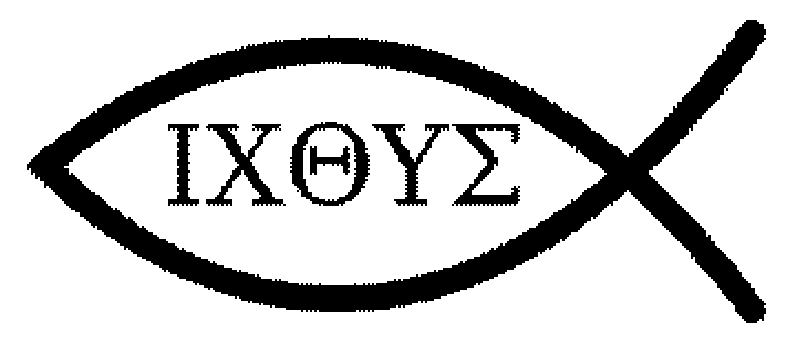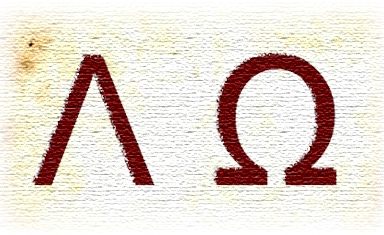
The use of the Ichthys symbol by early Christians.
Ichthus (ΙΧΘΥΣ, Greek for fish) can be read as an acrostic,
a word formed from the first letters of several words. It compiles
to "Jesus Christ, God's son, savior," in ancient Greek "Ἰησοῦς
Χριστός, Θεοῦ
Υιός, Σωτήρ", Iēsous Christos, Theou Huios, Sōtēr.
- Iota (i) is the first
letter of Iēsous (Ἰησοῦς),
Greek for Jesus.
- Chi (ch) is the first
letter of Christos (Χριστóς), Greek for "Christ" or
"anointed".
- Theta (th) is the first
letter of Theou (Θεοῦ),
that means "God's", genitive case of Θεóς, Theos, "God".
- Upsilon (u) is the first
letter of huios (͑Υἱός),
Greek for Son.
- Sigma (s) is the first
letter of sōtēr (Σωτήρ), Greek for Savior.
The Ichtys (Fish) symbol was
a secret symbol by whom Christians would recognize each other.
Tradition tells us that during times of persecution, if a
Christian wasn’t sure about another person’s affiliation, s/he
would use a stick or twig and draw the top half of the symbol in
the dirt. If the other person completed the symbol of the fish,
they could embrace each other each other as fellow believers.
 Its
meaning is found in the fact that alpha (Α) and omega (Ω) are
respectively the first and last letters of the Classical (Ionic)
Greek alphabet. Twice when the title appears it is further
clarified with the additional title "the beginning and the end"
(21:6, 22:13). Its
meaning is found in the fact that alpha (Α) and omega (Ω) are
respectively the first and last letters of the Classical (Ionic)
Greek alphabet. Twice when the title appears it is further
clarified with the additional title "the beginning and the end"
(21:6, 22:13).
This phrase is interpreted by many Christians to mean that
Jesus existed from eternity (as the second person of the Trinity),
and will exist eternally. Alpha and omega are the first and last
letters of the Greek alphabet, signifying that God is "the
beginning and the end," or eternal. The symbols were used in early
Christianity and appear in the Roman catacombs.
The Alpha and Omega symbols are often combined with the cross,
chi rho, or other Christian symbols.

The Tri-Bar Cross, primarily used in the
Eastern traditions, has three bars instead of the single bar
normally attached.
The small top crossbar represents the sign that
Pontius Pilate nailed above Christ's head. It often is inscribed
with an acronym meaning “Jesus of Nazareth, King of the Jews”;
however, it is often replaced or amplified by the phrase "The King
of Glory" in order to answer Pilate's statement with Christ's
affirmation, "My Kingdom is not of this world".
There is also a bottom slanting bar. This
appears for a number of reasons. Claims of evidence indicate that
there was a small wooden platform for the crucified to stand on in
order to support his weight; in Jesus' case his feet were nailed
side by side to this platform with one nail each in order to
prolong the torture of the cross.
The bottom bar is slanted for two reasons, to
represent the very real agony which Christ experienced on the
cross and to signify that the thief on Christ's right chose the
right path while the thief on the left did not.

Church tradition tells the story of
Constantine (then one of three divided Roman emperors) positioning
his army at the Milvian Bridge for battle. At noon Constantine saw
a cross of light imposed over the sun and heard a voice saying:
In Hoc Signo Vinces
(In this sign you shall conquer). Not only Constantine, but
the whole army is said to have seen the sign. That night Christ
appeared to the emperor in a dream and told him to make a replica
of the sign and place it on his soldier’s shields. This would be a
sure defense in battle. Constantine did win the battle, became the
sole Roman emperor and later made Christianity the official
religion of the Roman Empire in the edict of Milan. Needless to
say that the Chi Ro became one of the most significant Christian
symbols in the Roman / Western church.

The plain cross as a Christian symbol or
"seal" came into use at least as early as the second century and
the marking of a cross upon the forehead and the chest was
regarded as a talisman against the powers of demons. Accordingly
the Christian Fathers had to defend themselves, as early as the
second century, against the charge of being worshipers of the
cross.
Although the cross was known to the early Christians, the
crucifix did not appear in use until the 5th century.
|